The People’s Comics: Using the Graphic Format To Teach About Current Events
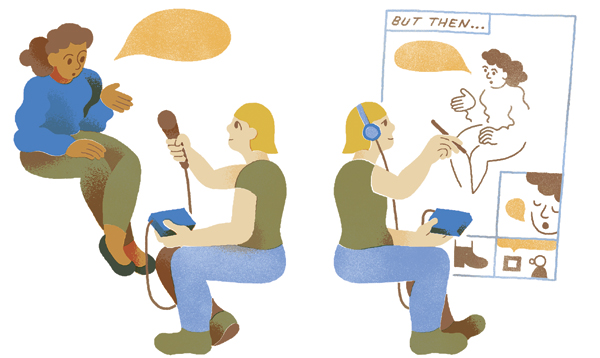
Illustration By Sophia Foster-Dimino
Graphic creators take on politics, from immigration to women’s rights
In the first issue of Occupy Comics (Black Mask, 2014), writer Alan Moore claims the word cartoon comes from the Italian word cartone, or cardboard, a reference to the caricatures of political opponents that 17th-century Italians scrawled on cardboard boxes. They could be seen by everyone and understood even by people who were illiterate.
Whether or not that story is accurate—cardboard boxes weren’t invented until the 19th century—it is true that historically, comics have been an excellent means for engaging with politics and current events. To take a famous example, in an 1831 caricature, French artist Charles Philipon depicts the head of King Louis Philippe morphing into a pear, in four stages.
For decades, editorial cartoons were the only comics that engaged with the news of the day. But as the graphic novel medium has become more popular, creators are using it for ambitious books about politics, international affairs, and other issues. For example, Brooke Gladstone and Josh Neufeld’s The Influencing Machine (Norton, 2011) depicts how the media works and where bias can creep in; Kate Evans’s Threads (Verso, 2017) is a firsthand report from the refugee camps of France; and Pratap Chatterjee and Khalil Bendib’s Verax: The True History of Whistleblowers, Drone Warfare, and Mass Surveillance (Metropolitan, Oct. 2017) is a critical look at the way big data is gathered, used—and misused. In addition, graphic memoirs such as Brigitte Findakly and Lewis Trondheim’s Poppies of Iraq (Drawn & Quarterly, Sept. 2017) bring students directly to the global issues in the news.
Online, creators use short comics to provide context on an issue, such as Andy Warner’s Failed State, a depiction of four decades of war in Afghanistan, and commentary, such as Adam Bessie and Erik Thurman’s essay on school choice and segregation.
Meanwhile, in an age when the tools for creating media are available to everyone, comics are talking back: the events of the past year have energized a number of creators to self-publish anthologies, often by crowdfunding, that address current issues. These projects make for interesting reading—and provide a model for students who want to make their own comics.
Although written for general audiences (not specifically for teens), such online comics and graphic novels are powerful tools to help students understand and think critically about the news. Ronell Whitaker, an English teacher at Harold L. Richards High School in Oak Lawn, IL, had his class read March: Book One (Top Shelf, 2013), the first volume of John Lewis’s graphic memoir, coauthored with Andrew Aydin and illustrated by Nate Powell. “It was great timing, because President Trump had recently gotten into a war of words with Lewis, and he [tweeted] something to the effect of ‘What has John Lewis done for civil rights?’ ” Whitaker says. “We made that one of our guiding questions as we read the book, and students kept coming back to that tweet and comparing it with Lewis’s work in the civil rights movement. It led to awesome discussion.”
Eric Kallenborn, an English teacher at Alan B. Shepard High School in Palos Heights, IL, also used the “March” series in class. “Many of our kids had a difficult time with the election,” he says. “[‘March’] allowed me to demonstrate the power of a movement in the face of tumultuous times.”
“Kids are eager to engage in analysis and discussion of topics that they may not get to chat about with family or friends,” adds Kallenborn. “Sometimes we search for people to have deeper conversations with. I try to make my classroom a place where those things can happen.” Graphic novels that Kallenborn uses regularly in class include Josh Neufeld’s A.D.: New Orleans After the Deluge (Pantheon, 2009) and Brian K. Vaughan and Niko Henrichon’s Pride of Baghdad (Vertigo, 2006).
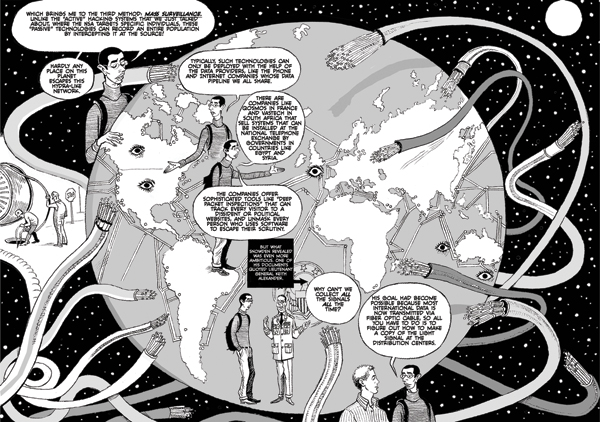
Pratap Chatterjee and Khalil Bendib’s "Verax"
Courtesy of Henry Holt & Company/Metropolitan Books
Political viewpoints; immediate impact
Most comics about current events have a point of view, and more often than not, it’s on the liberal side of the political spectrum. Journalistic comics with a conservative slant are rare, something that conservative commentators have noted. On the other hand, “most of the time, [these works] tell a story of a person or a time [in the midst of] an injustice,” Kallenborn says. “It’s hard to argue against fair and unbiased treatment of people.”
A controversial scene is an opportunity for conversation. “I try to keep my classroom a place of intelligent discussion, because I try to see all sides of an argument,” he adds.
The visual aspect of comics allows creators to present complex information easily—and skip lengthy descriptions. It also provides an immediacy that prose alone can’t. When investigative journalist Chatterjee began to research how intelligence agencies collect, use, and misuse data from citizens, he decided to show his work—literally. Chatterjee teamed up with artist Bendib to produce Verax: The True History of Whistleblowers, Drone Warfare, and Mass Surveillance.
“Verax breaks down a fantastically complex story and makes it accessible to all,” says Riva Hocherman, executive editor at Metropolitan Books. “The connections between government, intelligence agencies, tech companies, journalists, and whistleblowers are complicated and tangled. What better vehicle for simplifying the story—without sacrificing the detail—than comics? It’s hard to think of a better way to show how the mechanics of electronic surveillance work than illustration.”
Comics also allow the author to include diagrams, maps, and other visual aids to explain issues clearly. In Economix: How Our Economy Works (and Doesn’t Work), in Words and Pictures (Abrams, 2012), writer Michael Goodwin and artist Dan Burr take readers on a quick trip through the history of economics, from the Middle Ages to the present. They post updates on their website, often using diagrams to explain economic concepts.
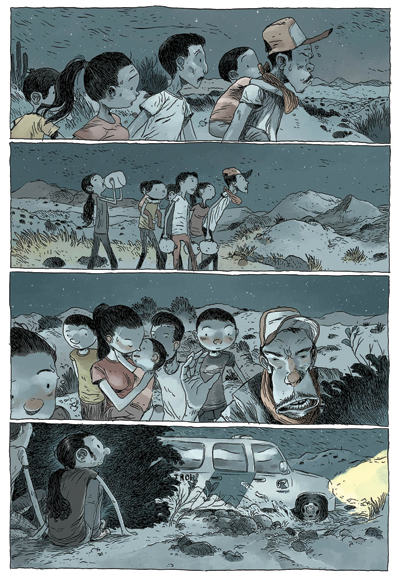
Tony Sandoval’s "Rendez-vous in Phoenix"
Courtesy of Lion Forge
Personal stories: living the news
First-person accounts of surviving a disaster or living in a war zone can help students understand and empathize with the experiences of others. “In the teen room, YA readers seem to respond strongest to graphic memoirs like [Liz Prince’s] Tomboy and [Cece Bell’s] El Deafo, especially if they identify with the protagonists,” says Thomas Maluck, teen services librarian at the Richland Library in Columbia, SC. In the hands of a skilled storyteller, first-person books about global events are compelling reading in their own right. Because they show, rather than tell, what a place is like, they put readers in the center of the action.
Poppies of Iraq, for example, is Findakly’s account of her childhood in Mosul, Iraq, and her return to the vastly changed country as an adult. Short vignettes of small incidents at school and at home build to a larger picture of Findakly’s family, their lifestyle in the early 1960s, how repeated government coups affected her and her family, and how the country deteriorated over years of war.
In Kobane Calling (Lion Forge, Oct. 2017) the Italian cartoonist Zerocalcare chronicles his trip to Syria with an organization that works with the Kurds there. Zerocalcare has a cartoony style and a foul mouth, and he maintains a self-deprecating sense of humor, even when writing about this serious subject. Kobane Calling shows the human side of the Syrian conflict.
Kate Evans keeps herself in the background in Threads: From the Refugee Crisis, a graphic novel depicting her experiences as a volunteer in the refugee camp in Calais, France. Instead, she focuses on what those in the camp have to say—where they came from, why they left their homes, and what their lives are like now. Evans also chronicles the lives of the volunteers who work hard to improve living conditions in the camps, only to see their efforts frustrated by the French government, which bulldozed the refugees’ improvised homes and intercepted food deliveries to the camps. In one scene, French soldiers threw baguettes on the muddy ground and stomped on them—ostensibly for reasons of safety and order.
As a teenager stuck in a small town in Mexico in 1998, Tony Sandoval made the impulsive choice to cross the border illegally into the United States to be with his girlfriend. In Rendez-vous in Phoenix (Magnetic, 2016) he describes his three attempts to enter the country, putting his safety in the hands of complete strangers and twice ending up in custody; the third time he made it across. It’s a compelling look at the realities of crossing the border.
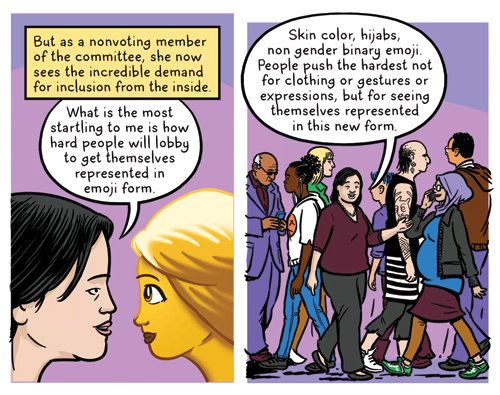
Warner’s online comic "Want a New Emoji?
Good Luck.", published on The Nib.
Emoji comic excerpt by Andy Warner for The Nib
Right now on the Internet
A number of newspapers, including the New York Times and the Guardian, commission nonfiction comics as part of their news coverage. In fact, a recent issue of the New York Times Magazine was entirely in comics format, with most of the stories adapted from articles that had previously run in the magazine. The Nib website specializes in short-form comics, both opinions and journalism, and Fusion (Fusion.net) makes frequent use of comics as well. Often, the information is similar to what one would read in a news article or op-ed, but presented in visual form. In addition, longer stand-alone pieces such as Michael Keller and Josh Neufeld’s Terms of Service: Understanding Our Role in the World of Big Data provide an in-depth look at a single topic in a format that is widely accessible.
“I think a lot of people are really visual learners, and comics can help boil down and explain some pretty complicated topics,” says Andy Warner, a frequent contributor to the Nib who has produced comics on everything from North Korea, with Morgan Pielli, to where emojis come from. For his more topical comics, Warner says, “I read and listen to a pretty huge amount of news and political media. I try to anticipate what might be coming into the news in the next few weeks and create a story surrounding that. I’m aiming to make complicated stories and ideas accessible.”
While political cartoons are alive and well at the Nib and other sites, Shannon Wheeler has compiled fanciful cartoons based on President Trump’s tweets in the book Sh*t My President Says (Top Shelf, August 2017).
How true is it?
In terms of accuracy of information, comics should be approached with the same scrutiny as any other medium. Regarding bias, in some ways it’s easier to evaluate comics: the medium’s storytelling nature means that the creator is often part of the story, making partiality more obvious. It’s also key to determine (and it’s not always obvious) whether the story is fiction or nonfiction.
Some graphic novels include bibliographies and other resources, allowing readers to follow up and use the book as a springboard for further research. Hocherman says, “Much of the information [in Verax] is drawn from published documents, reporting, documentaries, and interviews, and these have been fact-checked.”
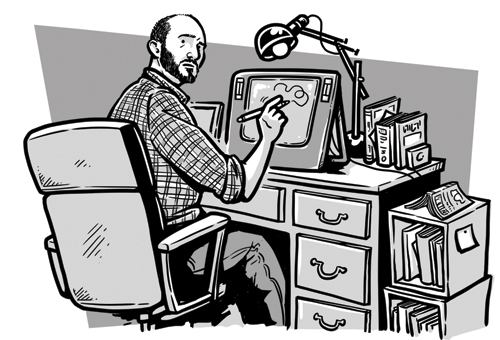
A self portrait by Andy Warner
Courtesy of Andy Warner
Chatterjee also does scrupulous research. “I’ve been a reporter for 32 years. I don’t take anything at face value. I look for multiple sources and contrarian views to my own.” He also develops a wide network of resources on all sides of the issues he covers.
Warner, who often makes comics about the Middle East, has a degree in Near Eastern Studies from Cornell University and an MFA from the Center for Cartoon Studies. “For research, I do a pretty deep dive,” he says. “I start out online and find some solid sources, then check out a bunch of books from the library and speed-read them, and finally try to log an interview with a trusted authority on the subject. Since I create comics on a wide range of topics—from giant fighting robots to ISIS—I can’t be an expert on everything. Figuring out who to trust and how to communicate what they’re saying about something is a big part of the job.”
Taking it to the streets
Comics have always had a subversive streak. Starting with the rise of the Occupy movement, creators have used crowdfunding and other methods to produce works—usually anthologies—responding to the issues of the day. One of the first was Occupy Comics in 2014, funded via Kickstarter. Françoise Mouly, publisher of TOON Books and cofounder of Raw magazine, and her daughter, Nadja Spiegelman, launched a comics anthology called Resist!. With the slogan “Women’s voices will be heard,” the self-published first issue included comics by Lynda Barry, Roz Chast, and a 13-year-old girl, among others. Activists distributed 58,000 free copies at the Women’s Marches across the country the day after the 2017 presidential inauguration. A second issue is in the works. Comics for Choice, available this fall, is an anthology of stories about abortion and a fund-raiser for the National Network of Abortion Funds.
Meanwhile, the anthology APB: Artists Against Police Brutality (Rosarium, 2015), edited by Bill Campbell and Jason Rodriguez, features comics and essays designed to spark a conversation about police treatment of people of color, in the wake of the killings of Michael Brown, Eric Garner, and others.While not all the material in these anthologies is appropriate for high schoolers, they point to a way for teens to get involved in current affairs. Platforms such as Tumblr and Instagram, along with crowdfunding tools, let creative teens make their own comics and amplify their voices beyond their immediate circle. There’s precedent for this: during the civil rights movement, an organization called the Fellowship of Reconciliation published and distributed the comic Martin Luther King and the Montgomery Story, which told the story of the Montgomery bus boycott and offered advice for those taking part in acts of civil disobedience. The comic was one inspiration for Lewis’s “March.”
That’s right: a comic book helped change the world. With better tools than ever before, today’s creators and readers have the opportunity to do that again.
CAMPBELL, Bill, John Jennings, & Jason Rodriguez, eds. APB: Artists Against Police Brutality. Rosarium. 2015.
Gr 10 Up–A collection of comics, essays, and stand-alone art that takes the deaths of Michael Brown, Tamar Rice, and others as a starting point to examine the American justice system and structural racism—and expand the conversation around these issues.
CHATTERJEE, Pratap. Verax: The True History of Whistleblowers, Mass Surveillance, and Drone Warfare. illus. by Khalil Bendib.. Metropolitan.
Gr 11 Up–Chatterjee, an investigative reporter, looks into the use of mass surveillance by U.S. intelligence services, and its misuse in drone warfare, where bad data has resulted in the killing of innocent civilians. The process-oriented approach is similar to the structure of the podcast Serial: the book depicts Chatterjee following the thread of his investigations, but it also cuts away for scenes with Edward Snowden and other whistleblowers.
CHIKWANINE, Michel & Jessica Dee Humphreys. Child Soldier: When Boys and Girls Are Used in War. illus. by Claudia Dávila. Kids Can. 2015.
Gr 5-9–Chikwanine was kidnapped from his home in the Democratic Republic of Congo at the age of five by a militia group. He was drugged and forced to kill his best friend, but incredibly, he escaped after a short time and was reunited with his family. Chikwanine tells a highly violent but never graphic story, and the end matter includes background information and resources for those who want to help.
CUNNINGHAM, Darryl. The Age of Selfishness: Ayn Rand, Morality, and the Financial Crisis. Abrams. 2015.
Gr 10 Up–Cunningham starts with a biography of Ayn Rand, the founder of libertarianism, and shows how her politics mixed with personal entanglements and the consequences her philosophy had for the future—such as her influence on former Federal Reserve chair Alan Greenspan. Includes a list of sources.
EVANS, Kate. Threads: From the Refugee Crisis. Verso. Dec. 2017.
Gr 10 Up–This story started as a webcomic about Evans’s experiences as a volunteer in the refugee camp in Calais, France. After the webcomic was published, she made several more visits to that camp and others, forging friendships with the refugees, and chronicling the work of volunteers and organizations to improve their lives.
FINDAKLY, Brigitte & Lewis Trondheim. Poppies of Iraq. Drawn and Quarterly. Sept. 2017.
Gr 10 Up–Findakly grew up in Mosul, Iraq, and moved to France when she was a teenager. In a series of mostly one-page vignettes, she tells stories of everyday life, from the trivial to the disturbing, carefully building a portrait of her family and a particular place and time.
GLADSTONE, Brooke. The Influencing Machine. illus. by Josh Neufeld. Norton. 2011.
Gr 10 Up–Gladstone, the host of the NPR program On the Media, provides an insider’s look at journalism. With a mix of theory and anecdote, she discusses credibility, presentation, and media bias. Sources are provided.
 GLIDDEN, Sarah. Rolling Blackouts. Drawn and Quarterly. 2016.
GLIDDEN, Sarah. Rolling Blackouts. Drawn and Quarterly. 2016.
Gr 10 Up–Glidden follows a team of independent journalists on a trip through Turkey, Syria, and Iraq as they interview refugees in all three countries. This book is an interesting firsthand look at the ins and outs of journalism.
GOODWIN, Michael. Economix: How Our Economy Works (and Doesn’t Work), in Words and Pictures. illus. by Dan E. Burr. Abrams. 2012.
Gr 10 Up–This book provides a whirlwind tour of the “dismal science” that’s anything but. Starting with the Middle Ages, Goodwin and Burr explain how economics has developed over the years, spell out the basic concepts, and introduce the significant thinkers in the topic. The author and the illustrator take on a number of current topics, and they have posted more comics at the Economix Comix website. Includes bibliography.
SANDOVAL, Tony. Rendez-vous in Phoenix. illus. by author. Lion Forge. 2016.
Gr 9 Up–In the 1990s, Sandoval had himself smuggled across the border from Mexico to the United States; it took him three tries to make it, and in this graphic novel, he offers a fascinating first-person account of the experience.
SATTOUF, Riad. The Arab of the Future: A Childhood in the Middle East, 1978-1984. tr. from French by Sam Taylor. illus. by author. Metropolitan. 2015.
Gr 10 Up–The first volume of Sattouf’s trilogy tells of his childhood in France, Libya, and Syria, with a child’s-eye view of the way the politics and ideology of each country affected everyday life as well as his parents’ points of view.
SHLAES, Amity. The Forgotten Man: A New History of the Great Depression. adapted by Chuck Dixon. illus. by Paul Rivoche. Harper Perennial. 2014.
Gr 10 Up–Reading this book on the Great Depression is like watching a movie from the era: Wendell Willkie narrates a series of vignettes of the era, filling in with plenty of commentary. While not strictly connected to current events, the title provides an alternative, conservative/libertarian slant on the New Deal and economic theories that are still being discussed today.
WHEELER, Shannon. Sh*t My President Says. illus. by author. Top Shelf. 2017.
Gr 10 Up–Wheeler creates wry cartoons to accompany actual tweets by President Donald Trump.
ZEROCALCARE, Kobane Calling: Greeting from Northern Syria. Lion Forge. 2017.
Gr 10 Up–The Italian artist Zerocalcare traveled to Syria to get a firsthand look at the Kurdish resistance. The artist writes from the heart and from a very personal perspective, so this is more journal than journalism; he uses a cartoony style, peppers his account with f-bombs, and isn’t afraid to laugh at himself, even in the direst situation.
Online Comics and Comics Sites
Comics for Choice: An anthology that teamed comics artists with abortion activists and historians to tell a variety of different stories about abortion. The anthology was crowdfunded and will eventually be available for purchase online through the website.
Resist!: A print comic edited by Francoise Mouly and her daughter, Nadja Spiegelman, focusing on women’s issues. The current issue is available for free in some comic shops and bookstores and can also be ordered online.
The Nib: A site featuring short comics and political cartoons on a variety of topics in the news.
Cartoon Movement: Longer-form comics, mostly personal accounts relating to international affairs.
A Decade in Immigration Purgatory: My Struggle To Become an American Citizen: Juana Medina came to the United States from Colombia legally, but she spent 10 years in limbo trying to get a green card.
For Real: A webcomic documenting the lives of immigrant teenagers living in New York City, produced by the Lower East Side Tenement Museum
Terms of Service: Understanding Our Role in the World of Big Data: An online comic by Michael Keller and Josh Neufeld about the way big corporations collect data from our everyday activities.
RELATED
The job outlook in 2030: Librarians will be in demand
The job outlook in 2030: Librarians will be in demand
ALREADY A SUBSCRIBER? LOG IN
We are currently offering this content for free. Sign up now to activate your personal profile, where you can save articles for future viewing







Add Comment :-
Comment Policy:
Comment should not be empty !!!
Joshua Sloat
There's also journalist Jake Halpern and artist Michael Sloan's current collaboration, a New York Times comic strip entitled "Welcome to the New World." A recent Times article called it "the first fully reported, regularly published comic strip to appear in the Times." https://www.nytimes.com/2017/05/12/insider/times-journalists-use-words-photos-graphics-and-video-and-now-a-comic-strip.html?_r=2Posted : Aug 02, 2017 08:05